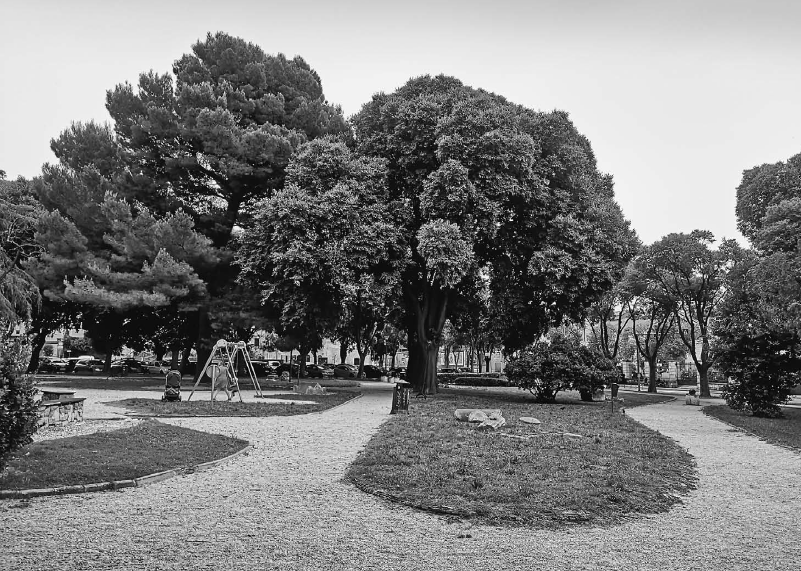Historical and Spatial Development of City of Graz Park (Block 21), Pula, Croatia
DOI:
https://doi.org/10.31522/p.33.1(69).1Keywords:
Archaeological integration, City of Graz Park (Block 21), Kolacio, Zdenko, landscape heritage, Pula, Croatia, urban heritageAbstract
The article analyses the historical and spatial transformation of Block 21 in Pula, currently occupied by the City of Graz Park. The aim is to trace the site's development from antiquity to the present day and examine the layered changes in its urban and landscape structure. The methodology combines the analysis of historical maps, archival documents, conservation and urban planning studies, as well as field research. Particular attention is given to the impact of World War II destruction, the post-war landscape concept by architect Zdenko Kolacio, and subsequent planning documents. The research shows that while the area has retained ecological value, its spatial structure and historical legibility have significantly changed. The findings contribute to a deeper understanding of the area’s urban development and provide a basis for further study of its urban, architectural and archaeological context.
References
Ancelj, F.B. (2013) ‘Hoće li argumenti snage (galame) nadjačati snagu argumenata? Tko to tamo ne voli Pulu? (7.12.2006.)’ In: Sto godina pulskih vizura: sabrani feljtoni & izabrani polemički članci, Pula: Cvajner: Društvo arhitekata Istre, pp. 249-257.
Barada, M. (2017) ‘241 - Pula - Park grada Graza’. Hrvatski arheološki godišnjak, 13, Zagreb: Uprava za zaštitu kulturne baštine, Ministarstvo kulture, pp. 439-440.
Buršić-Matijašić, K. (2007) Gradine Istre: Povijest prije povijesti. Pula: ZN „Žakan Juri“.
Franić, B. (2009) Kolacio, Zdenko [online]. Available at: www.hbl.lzmk.hr/clanak/kolaciozdenko [Accessed: 18.4.2025.]
Gnirs, A. (2009) Arheološki tekstovi (Original work published 1901-1916). Pula: Čakavski sabor.
Jurcan, E. (2020) ‘Antički spomenici kao ishodišta urbane transformacije Pule između dva svjetska rata’. Histria, 10, pp. 135-165. https://doi.org/10.32728/h2020.05
Krizmanić, A. (1986) ‘Povijesna jezgra’. Čovjek i prostor, 33(402), Zagreb: Savez arhitekata Hrvatske, pp. 6-9.
Krizmanić, A. (2005) ‘Prostorni razvitak austrijske Pule’. In: Bertoša, M. (ed.), Pula: tri tisućljeća mita i stvarnosti: tri tisuće godina povijesti Pule’; Pula: C.A.S.H., pp. 113-192.
Krizmanić, A. (ed.) (2008a) Stradarij grada Pule: Stradario della citta di Pola. Pula: Histria Croatica C.A.S.H.
Krizmanić, A. (2008b) Pulska kruna: Pomorska tvrđava Pula, Fortifikacijska arhitektura austrijskog razdoblja, Knjiga 1, Pula: Čakavski sabor.
Krizmanić, A. (2023) Građevine komunalnog sustava 1813.-1918., Pula: Povijesni i pomorski muzej Istre.
Marsetič, R. (2004a) I bombardamenti Alleati su Pola 1944-1945. Vittime, danni, rifugi, disposizioni delle autorita’ e ricostruzione, Rovinj, Trst: Centar za povijesna istraživanja Rovinj.
Marsetič, R. (2004b) ‘Saveznička bombardiranja Pule tijekom Drugog svjetskog rata’. In: Pula 3000 Pola: Prilozi za povijesnu sintezu: znanstveni skup održan u Puli 10. svibnja 2004. godine u povodu završnice obilježavanja tri tisuće godina grada Pule, Pula: C.A.S.H., pp. 151-164.
Marsetič, R. (2005) Saveznička bombardiranja Pule. In: Bertoša, M. (ed.): Pula: tri tisućljeća mita i stvarnosti: tri tisuće godina povijesti Pule. Pula: C.A.S.H., pp. 289-306.
Marušić, B. (1956) „Dva spomenika zgodnjesrednjeveške arhitekture iz južne Istre“, u: Arheološki Vestnik, VII, Ljubljana, str. 143-174.
Marušić, B. (1967) Kasnoantička i bizantska Pula, Pula: Arheološki muzej Istre.
Matijašić, R. (1980) ‘Colonia Iulia Pula’. In: Latina et Graeca, 1(16), Institut za klasične jezike i antičku civilizacija Latina et Graeca, pp. 33-50.
Matošević, I. (2004) „Parkovne površine kao rezultat planskih rješenja ili ne?“ In: Pula 3000 Pola: Prilozi za povijesnu sintezu: znanstveni skup održan u Puli 10. svibnja 2004. godine u povodu završnice obilježavanja tri tisuće godina grada Pule, Pula: C.A.S.H., pp. 165-179.
Meder, J. (2003) Podni mozaici u Hrvatskoj od 1. do 6. stoljeća, Zagreb: Ministarstvo kulture Republike Hrvatske, Uprava za zaštitu kulturne baštine.
Mlakar, Š. (1957) ‘Neki novi antikni nalazi u Istri’. In: Jadranski zbornik II: prilozi za povijest Istre, Rijeke i Hrvatskog primorja, Pula: Povijesno društvo Hrvatske, pp. 433-465.
Nefat, B. (2009) Lenzi, Luigi [online]. Available at: https://www.istrapedia.hr/hr/natuknice/70/lenzi-luigi# [Accessed: 12.4.2025.]
Regan, K. and Nadilo, B. (2010) „Stare crkve u najstarijim gradovima južne Istre“. Građevinar, 62(4), pp. 331-344.
Ujčić, N. (2021) Povijesna jezgra grada Pule nakon Drugog svjetskog rata: prazni prostori i interpolacije, diplomski rad, Odsjek za povijest umjetnosti, Filozofski fakultet Sveučilišta u Zagrebu.

Downloads
Published
Issue
Section
License
Copyright (c) 2025 Iva Rechner Dika, Alan Braun, Marin Duić

This work is licensed under a Creative Commons Attribution 4.0 International License.
Copyright (c) 2021 authors and journal.
This work is licensed under a Creative Commons Attribution 4.0 International License.
Authors who publish with this journal agree to the following terms:
In agreeing this form, you certify that:
- You read the ethical codex of the PROSTOR available at journal web.
- You submitted work is your original work, and has not previously been published and does not include any form of plagiarism.
- You own copyright in the submitted work, and are therefore permitted to assign the licence to publish to PROSTOR.
- Your submitted work contains no violation of any existing copyright or other third party right or any material of an obscene, libellous or otherwise unlawful nature.
- You have obtained permission for and acknowledged the source of any illustrations, diagrams or other material included in the work of which you are not the copyright owner.
- You have taken due care to ensure the accuracy of the work, and that, to the best of your knowledge, there are no false statements made within it.
- All co-authors of this submitted work are aware of, and in agreement with, the terms of this licence and that the submitted manuscript has been approved by these authors.






